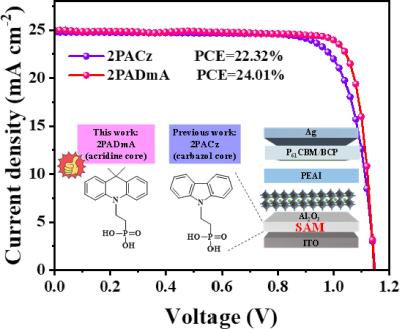Researchers from China's Yunnan University, University of Science and Technology of China and Southwest United Graduate School have synthesized a new dimethyl acridine-based self-assembled monolayer (SAM), [2-(9,10-dihydro-9,9-dimethylacridine-10-yl)ethyl] phosphonic acid (2PADmA), for use as a hole transport layer in inverted PSCs.
Image credit: Energy Materials and Devices
This novel dimethyl acridine-based SAM, 2PADmA, when used as a hole-transporting layer in inverted PSCs, can modulate perovskite crystallization, enhance carrier transport, passivate defects, and reduce nonradiative recombination. The resulting 2PADmA-based devices reportedly achieved a power conversion efficiency (PCE) of 24.01%, significantly higher than the 22.32% PCE of devices using the commonly employed 2PACz SAM.
This increased performance is primarily attributed to an improved fill factor (FF) of 83.92% compared to 78.42% for the 2PACz-based devices. Additionally, the 2PADmA-based devices showed enhanced stability, retaining about 98% of their initial PCE after 1080 hours of dark storage and 87% after 400 hours of heating at 85°C, demonstrating superior performance and durability.
Dr. Bing Cai, the lead researcher from Yunnan University, stated, "The development of the 2PADmA SAM represents a significant advancement in the field of PSCs. This novel SAM not only improves the efficiency and stability of PSCs but also offers a new approach to designing advanced HTLs for future solar cell technologies."
The innovative 2PADmA SAM can open up new possibilities for improving the efficiency and stability of PSCs, making them more viable for commercial applications.




